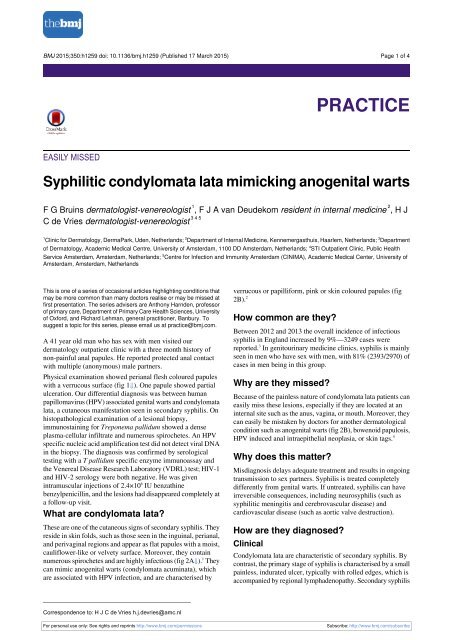condyloma-lata-case-report-bruins-bmj-2015
condyloma-lata-case-report-bruins-bmj-2015
condyloma-lata-case-report-bruins-bmj-2015
- No tags were found...
You also want an ePaper? Increase the reach of your titles
YUMPU automatically turns print PDFs into web optimized ePapers that Google loves.
BMJ <strong>2015</strong>;350:h1259 doi: 10.1136/<strong>bmj</strong>.h1259 (Published 17 March <strong>2015</strong>) Page 2 of 4PRACTICEThe bottom line• Condylomata <strong>lata</strong> are a cutaneous manifestation of secondary syphilis and can be misdiagnosed as genital warts• Prompt diagnosis and treatment with intramuscular benzathine benzylpenicillin are needed to prevent serious neurological complications(such as syphilitic meningitis and cerebrovascular disease), cardiac complications (such as aortic valve destruction), and ongoingtransmission• Initial diagnostic tests includes an anti-treponemal serological assay and an anticardiolipin test• Once <strong>condyloma</strong>ta <strong>lata</strong> are suspected, refer promptly to a specialist centre such as a sexual health clinic or to a (dermato-)venereologistfor further investigations (including sexually transmitted infection screen), treatment, contact tracing, and follow-upcan present with a variety of symptoms, most often amaculopapular rash, but also alopecia, leucoplakic orerythematous lesions on oral mucous membranes, and perianalor perivaginal <strong>condyloma</strong>ta <strong>lata</strong>.InvestigationsA clinical suspicion of syphilis is initially confirmed byserology, using an anti-treponemal serological assay (forexample, the T pallidum enzyme immunoassay, which is usually<strong>report</strong>ed as positive or negative or as a semi quantitative index;or the T pallidum haemagglutination assay (TPHA)) and ananticardiolipin test (such as the VDRL test, <strong>report</strong>ed as titre).In primary syphilis, serological tests can be falsely negative inthe window phase, so serology may need to be re-evaluatedafter several weeks; the TPHA and VDRL tests have 70.4% and74.9% sensitivity, respectively. In secondary syphilis serologicaltesting is highly sensitive—98.6% and 97.4% for TPHA andVDRL tests, respectively 5 ; VDRL also usually shows a hightitre (>1:16).In specialist clinics, dark field microscopy may be used todiagnose ulcerative primary stage lesions and <strong>condyloma</strong>ta <strong>lata</strong>,by visualising T pallidum in lesional exudate. This is a cheapand quick diagnostic method but requires a specialisedmicroscope and expertise.To differentiate syphilitic <strong>condyloma</strong>ta from HPV inducedmanifestations, such as genital warts or bowenoid papulosis, abiopsy is needed for histopathological examination. A denseplasma cell infiltrate and numerous spirochetes visualised byimmunostaining confirm <strong>condyloma</strong>ta <strong>lata</strong>. Numerous nucleicacid amplification tests to detect T pallidum have beendeveloped in house but are not available routinely. These testsare highly specific and sensitive in the diagnosis of primarysyphilis, irrespective of the serological window phase. 6How are they managed?It is advisable to refer patients suspected of having syphilis toa specialised setting, such as a sexual health or infectiousdiseases clinic, or to a (dermato-)venereologist, where additionalinvestigations and treatment are readily available and contacttracing and follow-up can be offered.The primary, secondary, and early latent stages of syphilis caneasily be treated with a single intramuscular 2.4×10 6 IU doseof benzathine benzylpenicillin. Patients diagnosed as havingsyphilis should always undergo tests for other sexuallytransmitted diseases, including HIV and hepatitis B serology,and nucleic acid amplification testing of urine, vaginal, anorectalor pharyngeal swabs (depending on the patient’s sexualpractices) for chlamydia and gonorrhoea. Furthermore, partnernotification is needed to prevent transmission, although thismay be a problem when sexual contacts are anonymous. 7 Menwho have sex with men who often have new or casual partnersare advised to be screened for sexually transmitted infectionsand HIV every three months. 3Contributors: FGB, FJvD, and HJdV all contributed to the acquisition,analysis, conception, design, drafting, and revision of the work and itsintellectual content; gave their final approval of the version to bepublished; and agreed to be accountable for all aspects of the work inensuring that questions related to the accuracy or integrity of any partof the work are appropriately investigated and resolved. HJdV isguarantor.Competing interests: We have read and understood BMJ policy ondeclaration of interests and declare the following interests: none.Provenance and peer review: Not commissioned; externally peerreviewed.Patient consent not required (patient anonymised, dead, or hypothetical).1 De Vries HJ. Skin as an indicator for sexually transmitted infections. Clin Dermatol2014;32:196-208.2 Edwards L, Lynch PJ, eds. Genital dermatology atlas. 2nd ed. Wolters Kluwer LippincottWilliams & Wilkins, 2011:205.3 Public Health England. Sexually transmitted infections and chlamydia screening in England2013. Health protection <strong>report</strong>. Vol 8, No 24. 2014. www.gov.uk/government/uploads/system/uploads/attachment_data/file/345181/Volume_8_number_24_hpr2414_AA_stis.pdf.4 Gearhart PA, Randall TC, Buckley RM, et al. Human papillomavirus differential diagnoses.http://emedicine.medscape.com/article/219110-differential.5 Anderson J, Mindel A, Tovey SJ, et al. Primary and secondary syphilis, 20 years’experience. 3: diagnosis, treatment, and follow up. Genitourin Med 1989;65:239-43.6 Heymans R, van der Helm JJ, de Vries HJ, et al. Clinical value of Treponema pallidumreal-time PCR for diagnosis of syphilis. J Clin Microbiol 2010;48:497-502.7 Kohl KS, Farley TA, Ewell J, et al. Usefulness of partner notification for syphilis control.Sex Transm Dis 1999;26:201-7.Cite this as: BMJ <strong>2015</strong>;350:h1259© BMJ Publishing Group Ltd <strong>2015</strong>For personal use only: See rights and reprints http://www.<strong>bmj</strong>.com/permissionsSubscribe: http://www.<strong>bmj</strong>.com/subscribe
BMJ <strong>2015</strong>;350:h1259 doi: 10.1136/<strong>bmj</strong>.h1259 (Published 17 March <strong>2015</strong>) Page 3 of 4PRACTICEFiguresFig 1 Condylomata <strong>lata</strong> in a man with secondary stage syphilis characterised by verrucous hyperkeratotic perianal papules.The <strong>condyloma</strong>ta latum on top shows partial ulcerationFor personal use only: See rights and reprints http://www.<strong>bmj</strong>.com/permissionsSubscribe: http://www.<strong>bmj</strong>.com/subscribe



